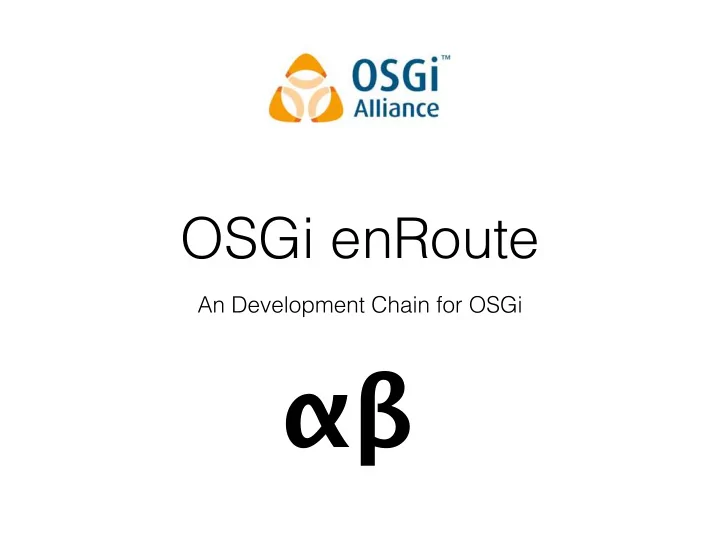

OSGi enRoute An Development Chain for OSGi αβ
B A C D B A
The existential question
Why OSGi?
“Hello World”
… is not a benchmark
Dev Chain Language
Small versus Large dynamic Java & languages OSGi cost of change However, long term cost is much lower Startup cost of Java (statically typed languages) is higher functionality
Your IDE knows exactly who is using this Javascript Java target.foo(15,”abc”); target.foo(15,”abc”); You KNOW target You HOPE target implements foo … implements foo … and expects an integer and a string
OSGi extends type safety to modules that evolve
What is OSGi enRoute? dynamic Java & languages OSGi cost of change functionality
How?
OSGi enRoute • µService Oriented Programming • To reduce system complexity • Dependency Management • To reduce errors in development & operations • Tooling • To reduce time to market • Documentation & Training • To reduce confusion with developers
Development Process test Components build enRoute � Profile Run � Deployable � compile define Descriptor Unit resolve other � API’s Distro baseline release external dependencies QA & Production staging
bnd, the little engine that built …
gradle, ant bndtools bnd maven (eclipse) command line bndlib
workspace cnf project project bundle bundle
profiles
Profiles • A profile is specific catalog of specifications that vendors can provide in a distribution . • An OSGi Profile consists of • µServices — Specifications of either OSGi Alliance or external µservices. • Extenders — An extender provides support functionality to OSGi bundles. • Capabilities — A capability describes a feature/function/ resource of the underlying system in abstract format.
Profiles • Each OSGi enRoute Profile is represented by a clean signed JAR library that can be used to build bundles against. • This is a specification only library, • It can not introduce unwanted dependencies, or • Let developers accidentally use proprietary features of a vendor
Planned Profiles • java 1.8 — All profiles are based on Java 1.8 • base — A minimum profile, mostly as common base and for demonstrations. It provides support for the best practices in our industry. • base.debug — Supports developing and debugging • web — Web application development optimized for single page web apps. • web.debug — Supports developing and debugging web apps. • persistence — Provides support for JPA on OSGi
Base Profile • OSGi Core Framework — R6 • OSGi Compendium — ConfigurationAdmin, Coordinator, EventAdmin, LogService, MetaTypeService,UserAdmin • Logging — Extensive Java Logging and SLF4J (dynamic!) logging support. Both service based an statics. • OSGi enRoute Support � • Requirements and Capabilities — Completely developed with the R&C model in mind • Specifications in code — Extensive support to use Java classes and interfaces to also specifies non-Java aspects. E.g. license headers, forms, versioning, etc. Mostly through annotations.
Base Profile • OSGi enRoute services � • Authenticator and Authority — For extensible security • ConfigurationDone — To signal end of initialization at startup • DTOs — Extensive support for Data Transfer Objects (JSON, conversion, diffing, named access) • Launched — Provides access to startup parameters • LoggerAdmin — Administrative front end to logging. Can handle OSGi, SLF4J, and Java Logging • java.util.Timer — Scheduled tasks • java.util.concurrent.Executor — Background tasks
dependency package com.api bind publish subscribe
Components Component (object)
Creates a component Can (de)activate, gets configuration data Service dependency
Bundles Bundle component component component component
Bundles Bundle
Private packages Calculated imports Exported packages bnd descriptor
Content, e.g. Component XML Continuous build JARs
external dependencies (or where the heck is maven central????)
Repository (includes maven central)
Opens browser window Search repos
Assemble OSGi Framework OSGi Framework Bundle Bundle Bundle Bundle Bundle Bundle
distros
Distros • A distro provides the runtime environment for one or more profiles • The OSGi enRoute project will deliver a reference distribution for all profiles based on open source and OSGi provided bundles • Members and other companies can provide other, competing, interoperable, distributions (And are actively encouraged to do so).
how do we prevent vendor lock-in?
Capability Model Requirement namespace Capability (foo>=14) foo =14 base =“bar” id =21
Capability Model Import osgi.wiring.package Export (& (osgi.wiring.package=com.acme) osgi.wiring.package=com.acme (version>=1.2) version=1.2 )
Debug Requirements Resolve requirements bndrun descriptor
Resolved bundles Running
staging
Staging OSGi Framework
Export
release
Semantic Versioning • major – Breaking change for consumers • minor – Breaking change for providers • micro – Invisible change
baselining
Released bundles
NoSuchMethodException
version wrong Incompatible API change
command line
continuous integration
summary
bnd(tools) gradle, bnd command IDE? line? Workspace Package Method Bundle Class parameters package method bundle class package method bundle return class jpm4j travis Continuous (maven central) Repository? Integration?
// TODO
TODO • bnd(tools) documentation • Base Tutorial • Additional profiles • Additional deployment standards • Create a community!
Recommend
More recommend